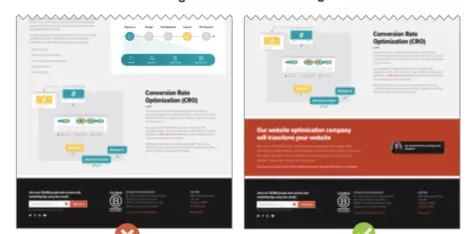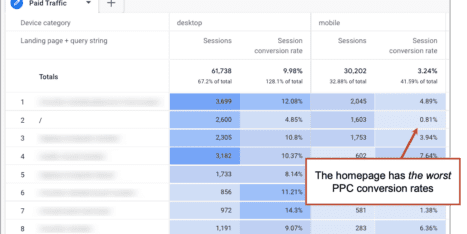Some sites get all the traffic. How do they do it? Are they publishing more? Are they just famous on social media? Is it email marketing? How?
There’s mostly one difference between high-traffic and low-traffic websites. Here it is: sites with big traffic have pages with information that people are looking for.
That might sound simple, but it’s not.
This post is going to lay out all of the steps to make one of those high-traffic pages and how to make it visible to the people who are looking for it.
Here’s how to increase targeted website traffic in 10 steps. We’ll use the example of the bicycle handbag company, Po Campo Bike Bags.
Fair warning: it’s a lot of work. But it’s worth it!
1. Pick a topic
Everything begins with an idea. But it can’t just be any idea. It has to meet these three criteria:
- You can write a truly great page on the topic.
That means you’re an expert on the subject. You probably have strong feelings about it. Your eventual goal will be to create the best page on the internet for the topic. - The topic is big.
It should be broad enough that to cover it thoroughly, you’ll be writing several thousand words …without adding fluff. - It’s useful to your target audience.
It may be only indirectly related to your business, but it must be directly related to your audience. It connects with their concerns and fears, hopes and dreams.
The ideal topics are those that don’t go out of style, such as how-to instructions, resources and answers to questions they’ll be asking next month and next year.
Example:
Po Campo makes handbags that work well for bicycle commuters. So their audience is interested in topics that relate to getting to work on a bike…
- Safe Commuting for Cyclists
- How to Carry more Stuff on Your Bike
- Do’s and Don’ts for Getting to Work on a Bicycle
- Bike Commuter Friendly Tips for Sharing the Road
Resource: Looking for a search-friendly blog topics?
Read What to Blog About: 13 Sources for Fresh Blog Topics.
2. Make a list of phrases that are related to the topic
Ask yourself: If I were looking for this article, how would I search? What words would I use? What phrases? Getting in the mind of your visitor-to-be is the key to increasing targeted traffic.
Empathy is everything in marketing.
Here are a few tips for building your initial list:
- Avoid jargon …unless your audience really uses it.
- Stick to phrases that are three to five words long.
- Consider phrases that are complete sentences or questions.
Write down your list on paper, in a spreadsheet or directly into your writing template.
Example:
Each of the article ideas can be aligned with a possible keyphrase. The headline and article will eventually be shaped around the phrase, but stay true to the topic. The goal is to make something valuable that your audience is looking for.
- “bicycle safety checklist”
- “bicycle commuter bags”
- “bicycle commute checklist”
- “bicycle etiquette”
3. Check the “Domain Authority” of your website
Domain Authority is a measurement of link popularity. That’s the number and quality of sites that link to you. It’s a key factor in search engine rankings. Domain Authority is actually an approximation of Google’s measurement which is called “PageRank.”
The authority of your website determines the general likelihood of ranking. Make sense? If not, here’s a short animation that explains how links work in Google.
To find your Domain Authority, visit Link Explorer and enter your domain. The free version can be used a few times per day, but you just need to use it once. Domain Authority changes very slowly over time.
Don’t worry about a high or low number, just look it up and write it down.
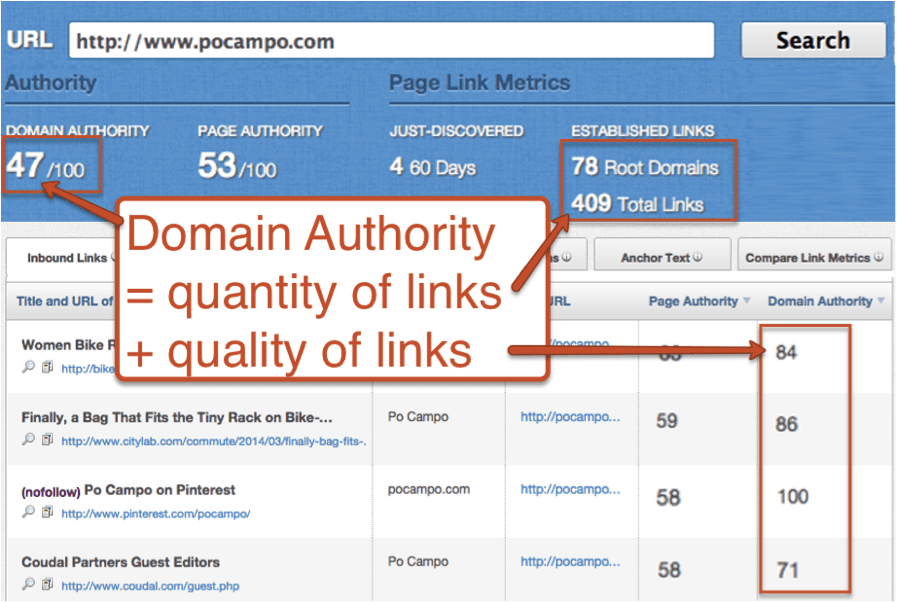
Link Explorer will also show you the number of websites that link to you, the total number of links and the quality of the top links.
4. Check the popularity of your keyphrases
Now we’re going check on our phrases. There are many tools for keyphrase research, but the Google Keyword Planner is the place to start.
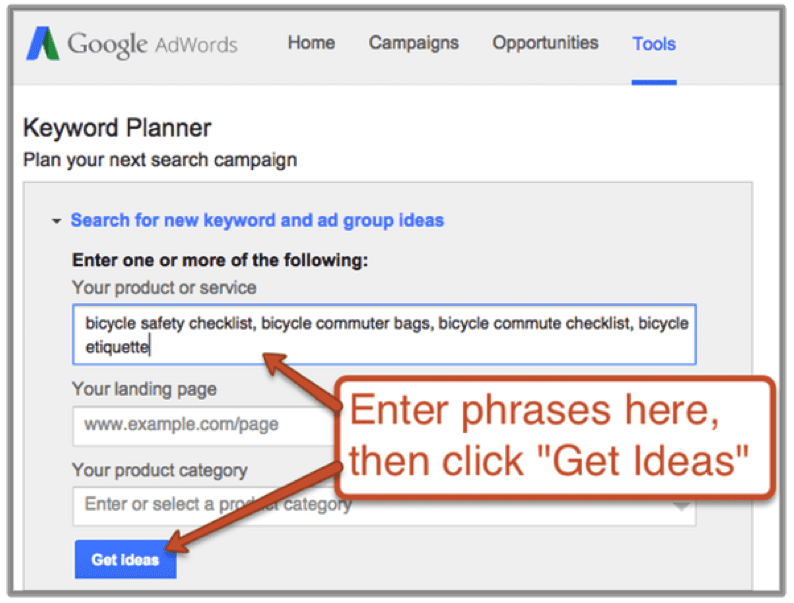
Enter several keyphrases into the box, separated by commas and click “Get Ideas” at the bottom. Next click the “keyword ideas” tab in the center of the screen.
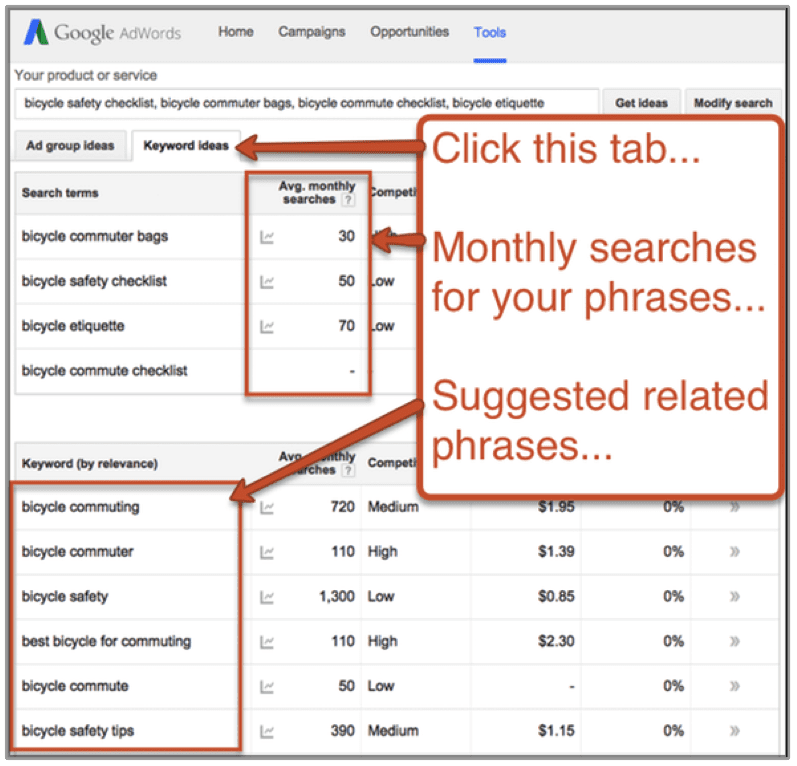
Now you’re seeing the average number of monthly searches for each phrase. If there’s a dash rather than a number, that means there are fewer than 10 searches per month on average for that specific phrase.
Caution! The specific numbers here are actually not that important or accurate. Within this tool, Google is only showing rounded-off “exact match” numbers. That’s the number of times the exact phrase was searched for precisely as if it was in quotes. The number of people searching for a general topic is always much higher.
Below the numbers, you’ll see a list of up to 800 related phrases. This should get your gears turning! Keep editing your list and checking more phrases.
We really want to get a basic idea of a few things:
- Are people actually searching for the phrase?
- What is the general order of magnitude for popularity? Dozens? Hundreds? Thousands?
- What other phrases might be even better?
See that competition column? Ignore it. That’s just showing competition for AdWords advertising. Our focus here is organic search, not pay-per-click.
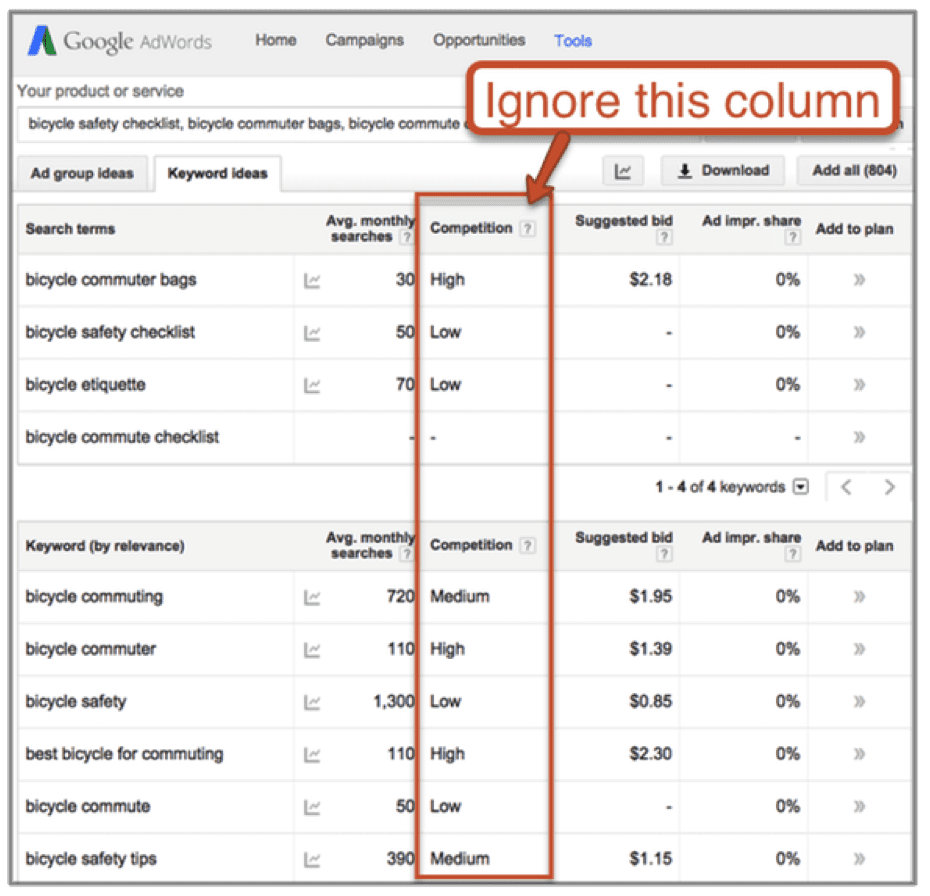
Later, we’ll check the specific competition for these phrases, but for now, we can start filtering. If your Domain Authority is low, you’ll likely have trouble ranking for popular phrases.
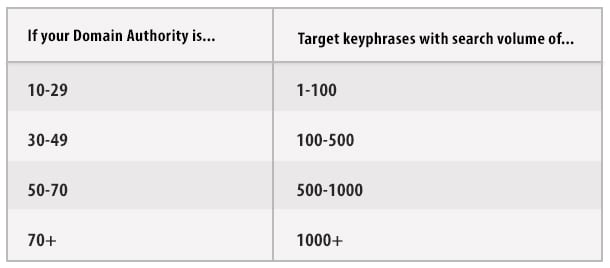
These are just guidelines. We’ll check competition in a more accurate way in step six. Still, if you’re way outside the ranges on this chart, go back and start again.
5. Search for the phrase in Google
Now let’s actually search for the phrases we’re considering targeting. Log out of any Google accounts and plug in the first phrase into the search box.
What does page one in Google look like? We’re mainly looking for three things…
- Am I in the right neighborhood?
If someone searching for your article found these search results, would they dig in and click? Or would they feel like they’re on the wrong trail and search for something else completely? - Is there a lot of visual noise?
Google keeps adding more to search results pages, like ads, products, images, local listings with maps, info boxes, etc. It’s called “universal search results.” Look carefully to see where the top-ranked page is. Is it buried under a lot of other stuff? These visual elements are distracting and would make a successful effort less effective. - Has Google bolded related words?
Google is paying more attention to the meaning of search terms and less attention to the combinations of letters and words. It’s called “semantic search.” Scroll through the search results and see if other phrases, not just the phrase you entered, are bolded. If you see synonyms and related words in bold text, that means Google has created a semantic link between your words and these words. Write these down.
If you’re in the wrong neighborhood or if there’s lots of visual noise, go back and try other phrases.
6. Turn on the MozBar and search again
Now we’ll really check competition. First, you’ll need to add the MozBar to your browser. It’s a Chrome Extension and Firefox Add-on. Once added, you’ll see a little ‘M’ next to the address bar in the top right of your browser.
Search for your phrase again in Google, then click it!
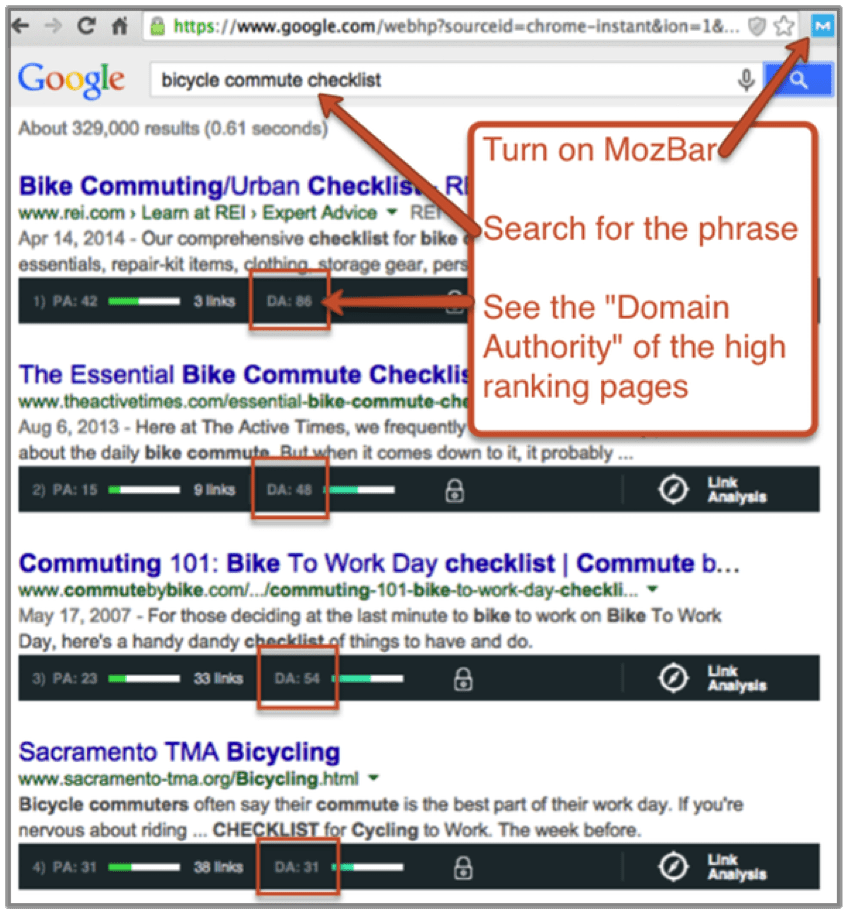
Now you’re seeing the “SERP Overlay” (SERP stands for “search engine results page” and it’s the geekiest jargon in the industry). MozBar is showing you the link popularity data for all the high ranking web pages. In other words, it’s overlaid the Link Explorer information, including Domain Authority.
Note: Page Authority (the link popularity of a specific page, rather than the overall domain) is more closely correlated with high rankings. But since we haven’t written our page yet, we can’t really compare our page authority to theirs! So we use Domain Authority instead…
If our Domain Authority and the Domain Authority of the high ranking pages are within the same range, then we’ve got a chance. Ideally, the Domain Authority of your site is in the range between the highest and lowest Domain Authority of the pages that rank on page one for the phrase.
Think of it this way; your site is a runner, a cyclist or a driver. And every keyphrase is a marathon, a bike race or a car race. Don’t expect to win a bike race on foot or a car race on a bicycle. But if you’re on a bike, you’ll win every marathon every time.
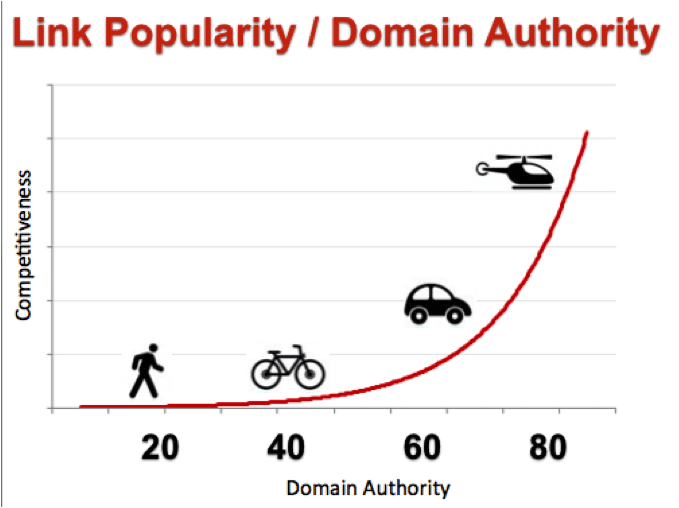
Note: Some of the high ranking pages may be on famous websites (Domain Authority of 90+). If so, it’s unlikely you’ll outrank them …unless their high ranking page isn’t very focused on the topic. If you can make a higher quality page that better indicates it’s relevance by using the keyphrase, you may be able to outrank them! More on using keywords in a bit…
If you’re below the range, then the phrase is too competitive for you. Go back and start again.
If you’re within the range, you’ve just found your target keyphrase.
7. Write the best page you possibly can
Here’s where the magic happens. Pour your heart and soul into it. Be concise in your language. Go deep into details. Give away your best advice and polish it with care.
These three factors are deal-breakers in creating pages that pull in targeted traffic.
- Length: The article should be long, not because it’s fluffed up but because the topic is big. Detailed articles tend to perform better in search engines. Learn more about the ideal length for blog posts.
- Formatting: Never write long, blocky paragraphs. Use sub-headers, bolding and bullet lists. It should also have images, diagrams, even video. Use this a checklist for web content.
- Headlines: Clever but unclear headlines don’t get clicked or shared. Use this checklist for writing headlines.
Remember, this will eventually be read by thousands of people. Write something epic!
8. Optimize the page for the keyphrase
You’ve written a stellar piece of content. It’s time to make sure it’s aligned with your target keyphrase. Targeted traffic comes from a page that zeros in on its topic deliberately.
Since you picked the phrase before you began writing, you likely had it in mind and used it several times. Let’s go back and check.
A search optimized page uses the phrases in the following ways
- Once in the <title> tag, ideally at the beginning. That means putting the name of your company at the end of the title tag.
- Once in the <h1> header. This is often the same as the title, but not always.
- Four to six times in the body of the article. In a 1000+ word article, you probably used it at least this many times already. Try to keep the phrase together with all of its words in order at least a few times.
- Use synonyms and related forms. If you noticed bolded related words (indicating semantic linking) in search results during step five, make sure to work these into your article.
Note: There are literally dozens of places you can use a keyphrase, from captions to comments, web addresses to “Alt” tags. Feel free to get tricky if you’d like. But generally, the less visible it is to readers, the less important it is to Google. So focus on those elements listed above. That’s what readers (and therefore Google) really care about.
The goal is to indicate the relevance for the phrase. Do not cram the phrase in there. Keyphrase stuffing is spam. Just use the phrase naturally in ways that help Google robots and human readers know what the page is all about.
9. Publish!
Edit carefully, then make it live. Now it’s time to promote. Here are the traffic-driving basics.
- Send an excerpt (teaser text) of the article out as an email newsletter.
- Share it with your social network many times over the next few days and weeks. When you share, mention the super specific people who are most likely to love it.
- Link to the article from older articles and related pages on your website. Use the target keyphrase in the text of the links. Here are more tips for internal linking.
Ideally, you’ve been building your email list and social followings all along. If not, that’s ok. Those things are very very helpful, but not necessary.
10. Wait a week… check your rank
It doesn’t take long to see if your page is ranking. Give it a few days, log out of any Google tools, then search for your phrase.
- Ranking on page one?
Congrats! You just increased your targeted traffic. Check your Analytics to see how much traffic you’re getting and how engaged those visitors are. - Ranking on page two?
You may have targeted a phrase that is too competitive for your site. But you might try editing the article to better indicate it’s relevance for the keyphrase. (step-by-step instructions here). Create a few more internal links from your existing pages. Improve the quality somehow. - Ranking on page three or lower?
Keep reading…
Never Give Up!
This is a slow way to increase targeted traffic, but it’s the main reason why some sites get much more traffic than others. When it works, you’ve got a magnet for traffic.
Rather than just a spike of email marketing and social media traffic, you’ll get a steady stream of targeted visitors to the page from search engines for months or even years.
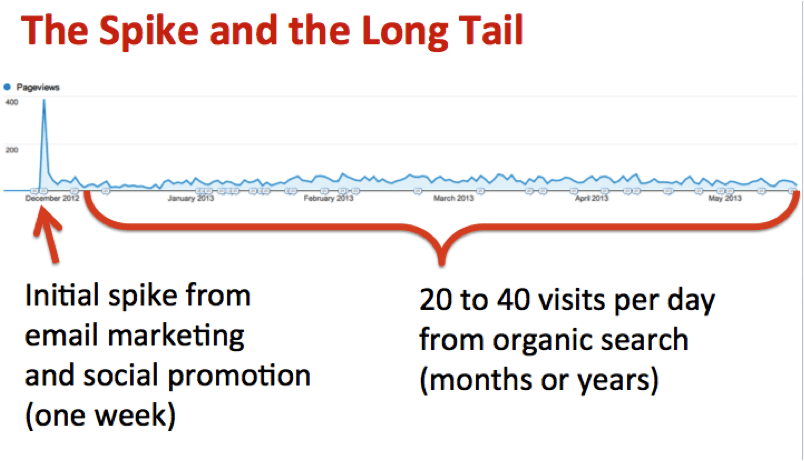
It’s hard work. But in the long run, it’s a lot less work than pumping out a steady stream of semi-relevant, short-lived posts that never rank. It’s worth the work.
If you try this and you don’t see results.
- Publish more articles on closely related topics
The more you publish on a narrow set of related topics, the more likely your site is to rank. Target related phrases, publish in different formats and collaborate with influential co-creators to create a central hub with spokes of content (one more bike reference!). - Make the page more visible to other content creators
The hope is that other content creators will find the page useful and refer to it in their content. If your article gets referenced / mentioned / linked, then it’s Page Authority improves and it’s more likely to rank …and get more targeted traffic. The key is to both produce something that’s truly worth mentioning and to build a network of friends who create similar content. This article (and video) may help: How Does Social Media Affect SEO? - Write a guest blog post on a related topic
Guest blogging is a legitimate way to create a press mention (and link) on a credible website. It’s a powerful but sensitive tactic that starts with empathy for the needs of the editor and their target audience. When used properly, a high-value article is published in your name on another site and potentially links back to the in-depth article on your website.
Remember, you’re an expert in your field. You have answers to questions that people are asking right now. You can publish information that people are searching for right now.
Target that traffic. Write and publish authoritative articles. Align them with keyphrases. Indicate the relevance. The main difference between high-traffic and low-traffic websites? Rankings and relevance!
Feel free to share your own advice and experience with other readers by commenting below.


